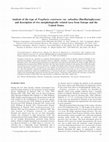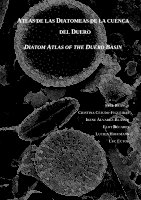Papers by Cristina Cejudo-Figueiras

Journal of Applied Phycology, 2008
A factorial experiment was carried out in order to assess the effects of four treatment steps in ... more A factorial experiment was carried out in order to assess the effects of four treatment steps in diatom processing techniques (the quantity of hydrogen peroxide added to the sample, the time allowed to the digestion reaction, the use of centrifugation and the method used to settle the frustules onto the coverslip) on different aspects of the quality of the resulting microscopic slide: the concentration of organic and inorganic matter, the density, randomness and homogeneity of the frustule distribution in the slide, and the abundance of broken frustules and girdle views. The results show no significant effects of any of the experimental treatments on the proportion of broken frustules in the samples. No significant effects were related to the duration of the oxidation reaction in any of the aspects evaluated in the quality of the slides. A sample: hydrogen peroxide ratio of 1:1 for a 6-h oxidizing reaction can be used to optimize the protocol. Despite being more time consuming, the use of successive decantations instead of centrifuging is more appropriate to achieve better results. Slide quality can also be improved by leaving the coverslips to dry at room temperature in order to improve the distribution of frustules.

Fragilaria construens var. subsalina is a common diatom found in a wide variety of aquatic system... more Fragilaria construens var. subsalina is a common diatom found in a wide variety of aquatic systems worldwide. It was described by Hustedt (1925) from brackish waters in Oldesloe, Germany; a lectotype specimen was established by Simonsen (1987). We analysed the ultrastructure of specimens from the lectotype material by means of light (LM) and scanning electron microscopy (SEM) and show that this taxon should be placed at the species level within the genus Pseudostaurosira (as Pseudostaurosira subsalina). A similar but distinct taxon from the United States, found in waters with low electrolyte content, is proposed as a new species of Pseudostaurosira, namely Pseudostaurosira americana sp. nov. We also describe a second new species from Spain (Pseudostaurosira alvareziae sp. nov.), found in waters with moderate conductivity, which was misidentified as P. subsalina in the past. A morphometric analysis of the valve shape supports the morphological separation between the three species. The present study clarifies the taxonomy, ecology and systematic position of these three taxa and provides a comparison with other, similar taxa.
Books by Cristina Cejudo-Figueiras

"The Duero River Basin, with an area of 97290 km2 and more than 40000 km of streams, is the large... more "The Duero River Basin, with an area of 97290 km2 and more than 40000 km of streams, is the largest one in the Iberian Peninsula, and lies mainly under Mediterranean continentalized bioclimate. Aquatic ecosystems are endorheic and main watercourses are regulated and highly anthropized. As in every lotic environment, benthic algae play a key role in the structure and functioning of its ecosystems and, within this group, diatoms represent the most abundant and diversified component. Their biological features make them excellent water quality indicators, and this has promoted their study at international level. As a result of the implementation of the Water Framework Directive of the European Union, ecological status biomonitoring networks have been established in all Iberian basins, based on the use, among others, of diatom indices, which has led to the need of more detailed taxonomic and ecological studies on these organisms. Despite their relevancy, such works are still scarce in Spain. In the Duero Basin, up to date more than 500 diatom species have been recorded, a high floristic richness that contrasts with analogue regions, this being related to the large diversity of environmental conditions included within this zone.
The aim of the present work is to elaborate a practical identification guide in accordance with the needs of technicians and biologists evaluating water biological quality in the Duero Basin. This book gathers the 200 main diatom taxa in terms of abundance and occurrence, selected from more than 600 samples of river epilithon collected during annual surveys carried out between 2003 and 2007 in the Spanish part of the basin. Certain taxa that could not be identified to specific level are also presented. For every diatom species, the following information is provided: a mor-phometric and autoecological description, a selection of illustrated bibliographic references and an iconographic series illustrating the taxon’s morphological variability, with a total of 3110 photographs in light and scanning electron microscopy gathered into 109 plates. The nomenclature, taxonomy and systematic position of taxa follow the most recent phycological literature. 116 species new to the Duero Basin and 34 species new to the Iberian Peninsula are presented."






Uploads
Papers by Cristina Cejudo-Figueiras
Books by Cristina Cejudo-Figueiras
The aim of the present work is to elaborate a practical identification guide in accordance with the needs of technicians and biologists evaluating water biological quality in the Duero Basin. This book gathers the 200 main diatom taxa in terms of abundance and occurrence, selected from more than 600 samples of river epilithon collected during annual surveys carried out between 2003 and 2007 in the Spanish part of the basin. Certain taxa that could not be identified to specific level are also presented. For every diatom species, the following information is provided: a mor-phometric and autoecological description, a selection of illustrated bibliographic references and an iconographic series illustrating the taxon’s morphological variability, with a total of 3110 photographs in light and scanning electron microscopy gathered into 109 plates. The nomenclature, taxonomy and systematic position of taxa follow the most recent phycological literature. 116 species new to the Duero Basin and 34 species new to the Iberian Peninsula are presented."
The aim of the present work is to elaborate a practical identification guide in accordance with the needs of technicians and biologists evaluating water biological quality in the Duero Basin. This book gathers the 200 main diatom taxa in terms of abundance and occurrence, selected from more than 600 samples of river epilithon collected during annual surveys carried out between 2003 and 2007 in the Spanish part of the basin. Certain taxa that could not be identified to specific level are also presented. For every diatom species, the following information is provided: a mor-phometric and autoecological description, a selection of illustrated bibliographic references and an iconographic series illustrating the taxon’s morphological variability, with a total of 3110 photographs in light and scanning electron microscopy gathered into 109 plates. The nomenclature, taxonomy and systematic position of taxa follow the most recent phycological literature. 116 species new to the Duero Basin and 34 species new to the Iberian Peninsula are presented."